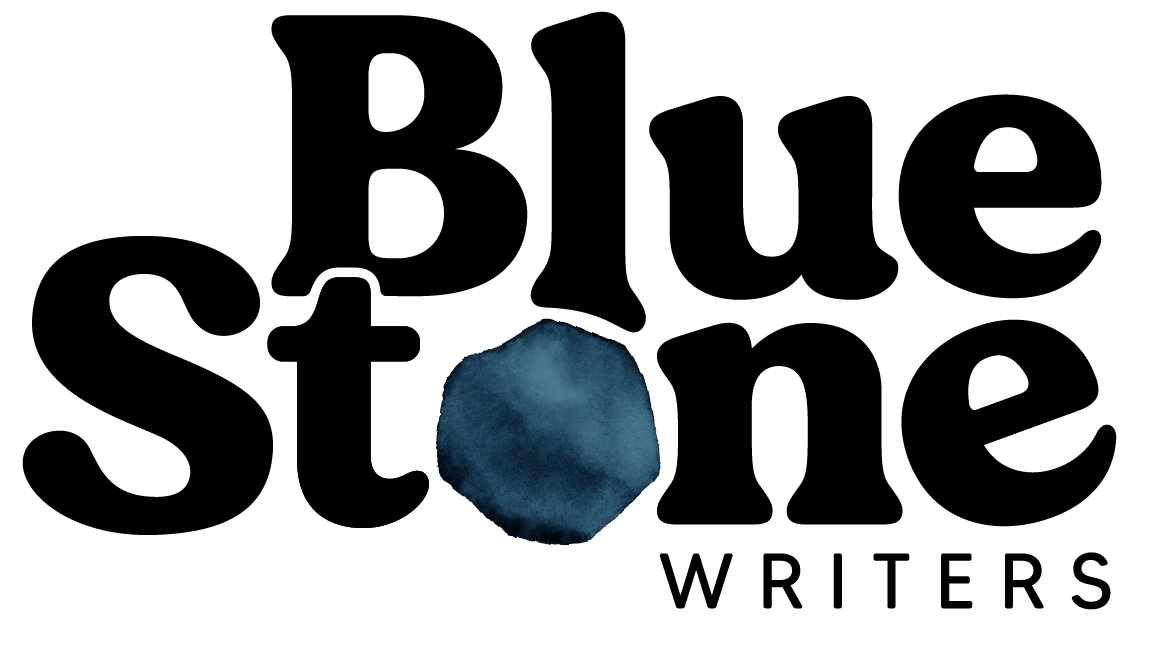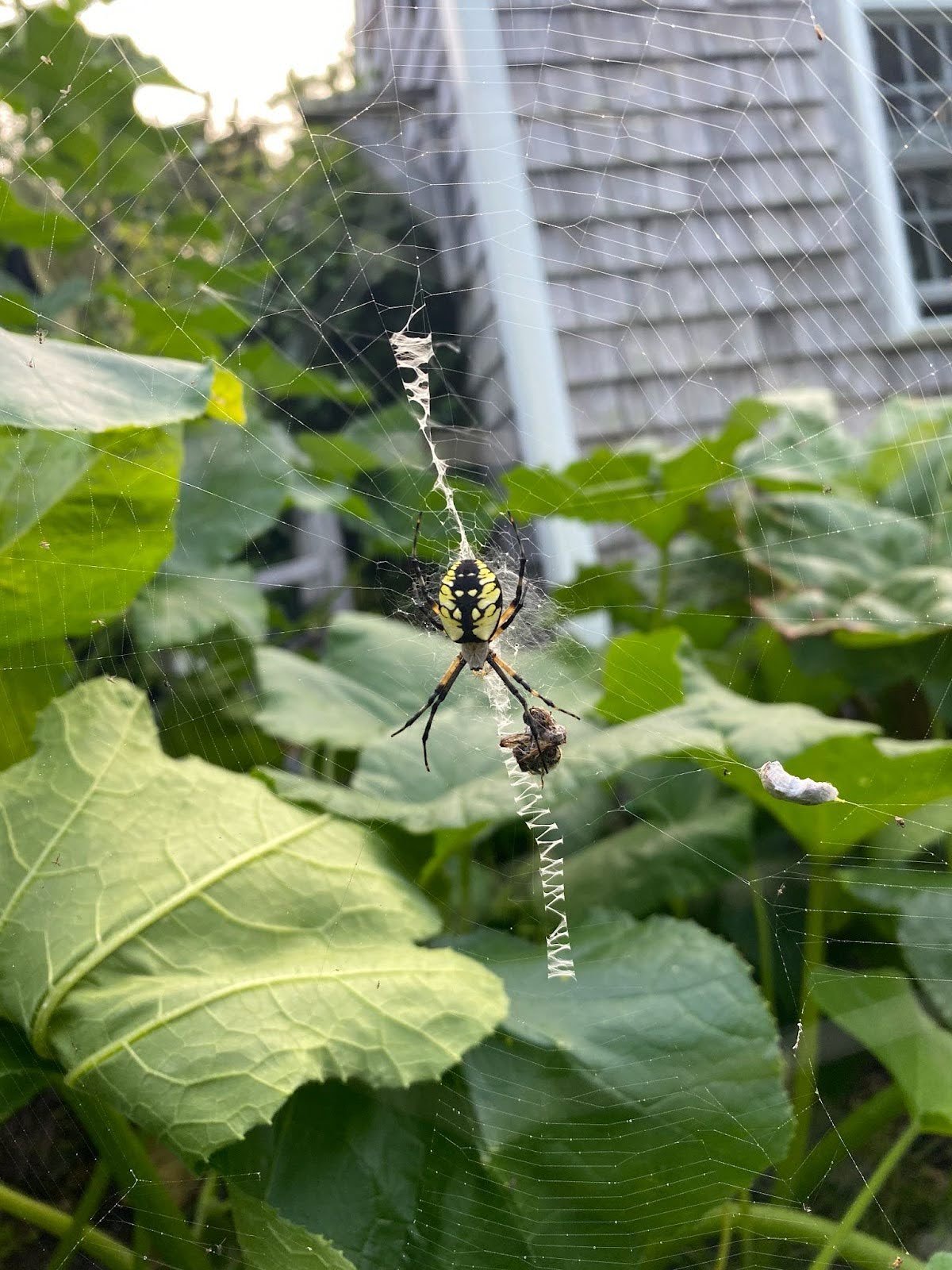guest post by Casey Bernard
This orb weaver is pulling threads to repair her web, reinforcing its weak points and building her home stronger than ever.
While applying for a writing residency, I reflected on the path that brought me to become a Blue Stone Writer. I was fumbling through writing my first novel and had the hardest time just sitting down and writing. Eventually, I found a MeetUp for writers, where I met fellow Blue Stone Kim and learned about the Writing Barn. I ended up at a weekend retreat Claire led, and before I knew it, I was regularly attending Claire’s online classes.
As a researcher by profession and knitter by obsession, I often like to think of these one-thing-leads-to-another situations as pulling threads.
In both storytelling and knitting, pulling a loose thread – a dangling idea or stitch – can fix a mistake, reveal a connection or completely destroy something that needs a do-over.
In my “real job” of qualitative research, I take the information gathered in interviews and tell a story about the consumer’s experience. When I conduct interviews, I always start with a discussion guide or an outline of the key questions I need to cover, but I leave a lot of time for exploration. Sometimes a participant will say something that requires probing or take us in a new and unexpected direction.
Moderators rely on a few key questions such as:
Tell me more about that. It’s amazing how this simple phrase can elicit so much more than the original answer provided.
Why is X important to you?
How does X make you feel?
What are the benefits you receive from X?
Is there anything else that is like X?
If you could not have X what would you use in its place?
How are they the same? How are they different?
A good moderator knows how to identify those loose threads and tug on them not only to get the conversation flowing, but to also reveal information or emotions that might be hidden under the surface.
As a knitter, I love the visual metaphor of pulling threads to get more out of an idea or story. Knitting in its purest form is a series of loops, never knots. If there’s a knot, there’s a problem.
Sometimes you make a mistake and have to pull the thread to get back to a place before the mistake happened.
In pulling the thread, you watch the stitches unwind and see where the errors were made and how the stitch is supposed to lay.
I recently spent some time in my garden watching an orb weaver spider meticulously weave her web. Similar to knitting, she followed the pattern, but in places that needed more reinforcement, she returned to make a thicker weave. The next day I noticed part of the web had been knocked down, but she was undaunted and made quick work of fixing the broken stitches.
Like the orb weaver, I am always at work building, unraveling, and repairing my novel.
I started with the story of Cassandra from Greek mythology. She warned those at the Trojan War not to bring the horse inside the walls of Troy, but no one believed her. I saw her story as relevant to so many women’s stories today, and I decided to bring her into the 2000s. But after my first draft, I felt like I needed more layers.
So, I started to pull a thread.
When researching the origins of Cassandra’s myth, I started reading about other women in the myths – Medusa, Persephone, Pandora and Hecate. I used my moderator tools to ask what else? Who else? How are these similar in what they tell us about women’s experiences? Like in my knitting, I pulled out the stitches of my story to find the places where I needed to insert a new one, fix a mistake or add reinforcements. I continue working on weaving these similar stories together to form one final piece.
Guided Writing: Pulling Threads
First, find a sweater in your closet. Look closely at how the stitches are formed. Consider places where the stitches are altered or changed to form the shape of the sweater. I won’t recommend pulling on a stitch unless you know how to fix it! Examine the garment for at least 4 minutes, taking notes if you like.
Next, find a loose thread in your story. Where can you explore a storyline or dig deeper to reveal another character? Try brainstorming different threads with a bullet-pointed list for 8 minutes.
Pick a bullet point (or maybe two!) to explore more deeply. Interview the subject of your bullet point, whether it’s a “character” or not, using a moderator’s approach to avoid yes/no questions and probe for more. Write for 12 minutes, using the example questions below as a guide.
Tell me more about that.
Why do you say that?
What do you like about it?
What are the benefits you get from that?
Why does it make you feel that way?
Is there anything else like that?
How are they similar? How are they different?
Examine the threads you pulled to see how they could be stitched back together. Then, take a cue from the orb weaver and thicken the stitches in places that need more reinforcements and reattach the places that got knocked down. Write for 15 minutes.
Casey Bernard is a writer and reader of mostly weird and dark books. In 2020 she and her family moved from Texas to a tiny town on the coast of Maine intending to wait out the pandemic but stayed. She’s a marketing researcher by profession, a knitter and is cultivating a new interest in growing food in the short-lived idyllic Maine summers.



